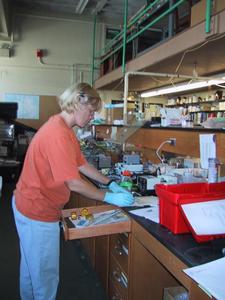26 June, 2001
Patience and Perseverance
A day at the University of Arizona shadowing my project’s research team
has shown me what incredible patience and perseverance this level of
science demands. I arrived here this morning ready to learn how to use
the instruments I will be operating while in Greenland. Simple enough,
mix some chemicals string up some tubing, fire up the computer and your
off! Superficially what it takes to analyze the snow and ice seemed
pretty straight forward . But, it’s all in the details. And those details
can be substantially more time consuming than one might appreciate until
you’ve been there.
Patience
The science process is a tedious one. Each chemical needs to be
carefully measured in clean conditions. The instruments demand careful
calibrations. Everything needs to be checked and rechecked, standardized
and scaled. Such is the care that is taken for every snow sample and ice
core that is melted here. I come away from today with such an awe and
respect for these people who have the patience and preserverance do this
type of work day in and day out. For many years.
Today alone we had to mix our own fresh reagents, carefully measuring and
stirring them. However, once we began the test procedure we discovered a
small clog in the tiny tubes that carry the melt water to the
instruments. To locate the plugged section of line we carefully
disconnected the tubes, isolating one section at a time. Once the
clogged section had been determined we spent close to an hour replacing
the little section (five cm) of tube, (the patience part ) From there it
was smooth sailing to test our standards and make sure the instruments
were calibrated. However, it was getting late so we called it a day.
Tomorrow we will melt some of the snow samples that were taken this
winter that are being stored here in giant freezers.
Perseverance
I asked at lunch how much ice and snow do they melt here. The reply was
they have close to one thousand meters of ice core stored waiting to be
melted and analyzed. On a good day they can melt just 15 meters of ice
and collect the data. That amounts to about six months of work just
melting ice! That is IF all goes well -- which isn’t always the
case, (refer to the patience part, above). From the point at which the
data, is collected the processing and analysis can begin. When I asked,
“what is the ratio of field work to lab and data analysis time?” The
answer surprised me. For this project Manuel and Regine replied, “it
works out to three months of ice coring and collection to two years of
thinking, data crunching and preparing to present the data and
conclusions” (the perseverance part). Again, I was impressed by this
team. They possess an extraordinary ability to focus and persevere so
that they can present information about our atmosphere to the scientific
community and world at large.
And I am only at the end of my first day here.

This is the office work and data processing part of the job. It can take many years to make sense of data and publish reports. Dr. Manuel Hutterli and Dr. Regine Rothlisberger are pictured here. Both have worked in this field for over 5 years.

Dr. Dee Belle-Oudry sorts through lab materials in preparation for melting snow.
Contact the TEA in the field at
.
If you cannot connect through your browser, copy the
TEA's e-mail address in the "To:" line of
your favorite e-mail package.
|
